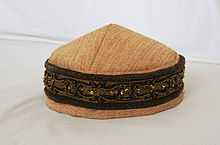Tubeteika

A tubeteika or tübätäy (Uzbek: Do'ppi/Дўппи, Tatar: Түбәтәй, Turkmen:Tahiya, Uyghur: دوپپا, ULY: Doppa Russian: Тюбетейка) is a Central Asian cap, today worn in Tajikistan, Kazakhstan, Kyrgyzstan, and Uzbekistan, as well as in Muslim-populated regions of Russia (mainly Tatars). The tubeteika is worn typically by the Turkic ethnic groups of the region. It bears some superficial resemblance to the yurt, another Central Asian cultural icon. The cap is called in Uzbek duppi or kalpoq and is considered an applied art form and an important part of the traditional folk costume.[1] Black with a flat, square base,[2] in Chust the caps are made with white embrodiery with "four arches [which] represent impenetrable gates that will keep all enemies at bay; the burning peppers protect against the evil eye; and the almonds or bodom are said to symbolise life and fertility".[3]
Also, there is a trend among Sephardic and Moroccan Jews to wear Uzbeki tubeteikas as a kippah.
References
- ↑ "Tubeteika suits everybody". Retrieved 11 July 2011.
- ↑ Mentges, Gabriele; Shamukhitdinova, Lola (2013). Modernity of Tradition: Uzbek Textile Culture Today. Waxmann Verlag. p. 115. ISBN 978-3-8309-7906-7.
- ↑ Lovell-Hoare, Sophie; Lovell-Hoare, Max (8 July 2013). Uzbekistan. Bradt Travel Guides. p. 117. ISBN 978-1-84162-461-7.
External links
| Wikimedia Commons has media related to Tubeteikas. |